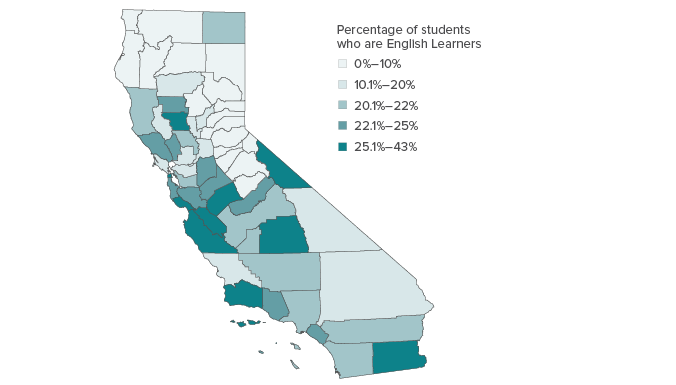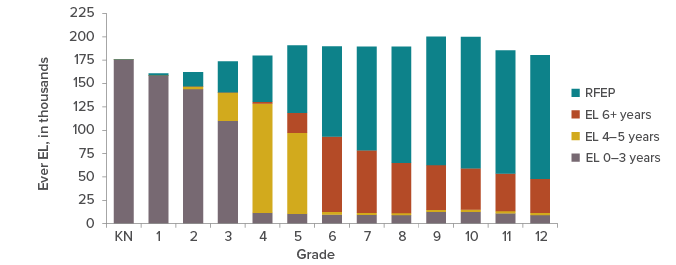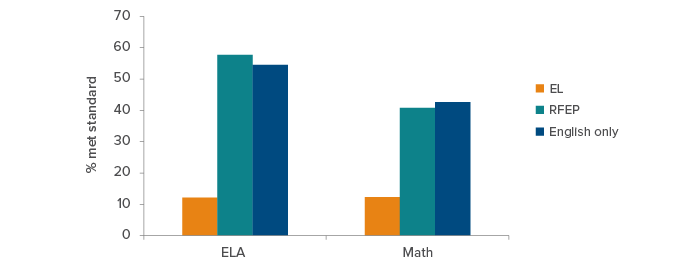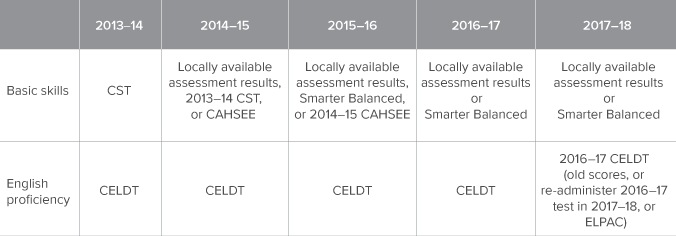Summary
English Learner (EL) students have been a key part of California’s K-12 system for decades. They currently make up about 21 percent of the public school population. English Learner status is meant to be temporary, and indeed, reclassified English Learners (those who are deemed English proficient) are among the best-performing students in the state. But students who remain ELs for longer periods generally have poor outcomes.
An important aim of recent reforms is to change how we fund, educate, assess, and hold districts accountable for EL students, and there are more changes on the horizon. This report highlights key demographic facts about English Learners, their progress through our schools, recent reforms that aim (at least in part) to narrow the achievement gap for English Learner students, and ways to improve EL outcomes in the future.
- Most English Learner students were born in the United States; the vast majority are Spanish speakers.
- Some English Learner students are reclassified relatively quickly, while others remain ELs for more than six years. There are new English Learner students entering California’s schools at every grade level, including grade 12.
- The Local Control Funding Formula is designed to elevate performance of English Learner students. Yet it is challenging to track spending and difficult to attribute outcomes to increased funding.
- The state’s accountability system has expanded district reporting requirements for English Learner students, but educators and policymakers could monitor progress more effectively with the use of longitudinal statewide data.
In the coming months, the state will be revamping its reclassification policies. It should consider three key ways to accelerate the progress of this important group of students. First, the new reclassification policies should be consistent across districts. Second, the new policies should take advantage of the new alignment between English language development standards and the Common Core standards. Finally, the state should consider allowing reclassification criteria to vary across types of ELs (e.g., students entering at different grade levels).
Introduction
In total, more than 40 percent of the students in California’s public schools speak a language other than English at home. In the 2016-17 school year, 21 percent (or more than 1.3 million) of all students were English Learners. When students who were formerly English Learners are added in, the population of “ever ELs’ expands to 38 percent of all K-12 students in the state.
Students entering K-12 schools in California are classified as English Learners if they speak a language other than English at home and score below a proficiency threshold on the California English Language Development Text (CELDT).1 EL status is meant to be temporary-when students demonstrate sufficient English language proficiency, their official designation changes to Reclassified Fluent English Proficient (RFEP).
English Learners are meant to have English language development instruction, either in stand-alone English language development classes (“designated”) or as part of regular instruction (“integrated”). EL students do receive core subject instruction, but English language development instruction may mean they have less of it. After they are reclassified, these students no longer receive English language development instruction and take core subjects without additional support.2
In order to be reclassified, students must demonstrate English language proficiency on assessments administered only to EL students and demonstrate basic skills in English that are comparable to native English speakers.3 Individual school districts make the decision to reclassify EL students based on a number of criteria recommended by the state.
Student outcome data has long revealed that EL students do not fare as well as their non-EL peers. Districts and schools with large numbers and/or proportions of EL students tend to have lower performance than districts and schools with lower numbers and/or shares of EL students. This was a key motivator for the Local Control Funding Formula (LCFF), enacted in 2013-14. The LCFF sends more funding per pupil to districts for English Learner and other “high need” students (those who are economically disadvantaged or foster youth), because these students have greater (and more expensive) educational needs. In 2017, the California Department of Education (CDE) reported that 85 percent of EL students were economically disadvantaged, as were 79 percent of former EL students. However, reclassified students perform much better than current EL students, and they sometimes perform better than students who do not speak a foreign language at home.
Recent policy changes demonstrate broad interest in reforming EL education. The state’s new academic standards, assessments, and instructional models, as well as a new funding formula are aimed, at least in part, at closing the EL achievement gap. These myriad policy changes prompted a group of stakeholders, including the California Department of Education (CDE) to come together to create a “roadmap” for English Learner policy in the state. The Roadmap’s aim is to help districts align their accountability plans with guidelines for ELs from the State Board of Education.4 In addition, California voters recently voted overwhelmingly in favor of Proposition 58, which loosens restrictions on bilingual education offered by districts that date back to the late 1990s.5 If schools and school districts expand their bilingual course offerings, demand for bilingual instructors may increase.6
This report provides a demographic overview of California’s English Learner students, describes a number of recent educational policy changes that impact these students, and highlights policy changes and opportunities going forward.
Who Are California’s English Learner Students?
California’s English Learner students are a diverse group. Of the more than 60 languages spoken, Spanish is by far the most common: 83 percent of ELs in California schools speak it at home. The next most common languages are Vietnamese and Mandarin, spoken by 2 percent and 1.6 percent of EL students, respectively. Arabic, Filipino, and Cantonese each make up about 1 percent of languages spoken.
Figure 1. Spanish dominates languages spoken by California ELs

SOURCE: CDE Dataquest 2016-17.
Most English Learners are not foreign born. Nationally, the Migration Policy Institute reports that 82 percent of EL students in grades pre-K through 5 are US born. The share of US-born EL students in grades 6 through 12 is lower (65%),7 mainly because of the arrival of older EL students and the reclassification of many students who started school as ELs. Overall, about 1.5 percent of all EL students in California have lived in the United States for less than one year. However, this share is higher among secondary students (2% of 7th and 8th graders and 3.7% of 12th graders).8 About 3 percent of all EL students in California have a parent who has moved within the last three years to pursue employment in agriculture or related industries.
Many US-born EL students come from families with a mix of immigration statuses. The Pew Research Center estimates that 12 percent of California’s K-12 students have a least one undocumented parent (Passel and Cohn 2016). In the current political climate, the state superintendent of instruction has suggested that parents and students should be told that their schools are safe havens from deportation (Jones 2017), and many school districts with EL student populations are eager to assure families that their students (and student data) are safe at school.
Where are the state’s English Learner students?
English Learner students are an important part of the student populations in rural, urban, and suburban school districts (Figure 2). Almost every county in the state has EL students-the lone exception is Alpine County, which has only 82 students. The counties with the largest shares of ELs are Imperial (43%), Monterey (40%), Colusa (38%), and Santa Barbara (33%). Not surprisingly, Los Angeles, Orange, and San Diego Counties have the largest numbers of EL students.
Figure 2. EL students live in almost every county

SOURCE: CDE Dataquest, 2016-17.
Of course, it is the distribution of EL students across districts and schools that matters, because it is at the level of schools and classrooms that most instruction and support is organized. Of the state’s 1,000 school districts, 963 have at least one EL student. The districts with the largest number of ELs are Los Angeles Unified, with 158,000 (25% of all students) and San Diego Unified, with 31,000 (24% of all students). Twelve school districts have student populations that are at least 70 percent EL, while nearly 350 school districts have fewer than 100 EL students. Districts and schools with low numbers of EL students may find it challenging to provide resources efficiently. Further, districts with fewer than 15 EL students do not have to report outcomes for them.
Even districts with hundreds or thousands of EL students may contain schools with very small EL populations. More than 9,900 out of approximately 10,000 schools statewide have at least one EL student, but there are more than 2,200 schools with fewer than 30 ELs,9 which is the threshold for school-level accountability requirements.
ELs enter school with differing English proficiency levels
A 2004 analysis used statewide data from one point in time to estimate that for half of EL students, it took about six years to be reclassified (Warren 2004).10 More recently, both the National Academy of Sciences (2017) and the California EL Roadmap (2017) have suggested five to seven years as a reasonable expectation.
ELs enter the K-12 system with differing levels of English language proficiency (Figure 3). ELs entering California schools in kindergarten are the least likely to score at the lowest proficiency level-they are more likely than older entering students to have an intermediate level of fluency. However, 90 percent of tested kindergarten students are classified as ELs, compared to 76 percent of 9th graders. Those entering at the beginning of middle school or high school are more likely to have beginning levels of fluency. As noted above, these students are also more likely to be immigrants.
Figure 3. ELs enter California schools with varying levels of English proficiency

SOURCE: CDE Dataquest 2016-17.
NOTE: Scores on initial CELDT for students scoring below Early Advanced.
A student’s initial level of English language proficiency is related to how long he or she remains an EL. California recently started recording the number of long-term ELs’students who remain ELs for six or more years-as well as students who are “at risk” of becoming long-term ELs-those who remain ELs for four to five years.11 The reasoning is threefold: (1) for many students, progress toward reclassification diminishes the longer they remain in the program; (2) the need for core content instruction becomes more acute in middle and high school; and (3) there is a stigma associated with being an EL student beyond elementary school (Olsen 2010). Some districts, such as Los Angeles Unified, have begun offering specialized instruction for long-term ELs in an effort to accelerate their progress.
Entering school with a higher level of English fluency generally results in earlier reclassification: English Learner students who start as kindergartners at higher English language proficiency levels are reclassified sooner than others (Thompson 2017). The varying strength of EL programs across districts and schools also plays a role in the amount of time it takes students to be reclassified. When we examine EL students by grade, we find that many have entered the ranks of reclassified ELs by the 6th grade but that a nearly equal number have become long-term ELs by that point in time. At higher grade levels, there are fewer new ELs (enrolled for three years or less) and more reclassified students. The number of long-term ELs is lower in grades 11 and 12, both because these students get reclassified and because they are more likely than other students to drop out of high school.
Figure 4. Some students take many years to reclassify

SOURCE: CDE Dataquest 2016-17.
Assessing EL Student Performance
The K-12 policy changes that aim to reduce inequality and improve educational outcomes for all students are particularly important for English Learner students. This section outlines the impact of these recent changes on English Learners.
Academic Standards and Assessments
California has adopted a number of new standards-for math, English Language Arts (ELA), science, and English language development (for ELs)—over the past decade. In addition, there are new assessments to measure students’ mastery of and progress toward meeting each of these new standards.
Common Core standards and Smarter Balanced assessments
California adopted the Common Core State Standards in 2010. As has been widely reported, this transition has been uneven across the state (Warren and Murphy 2014). The Common Core standards were expected to present additional challenges for EL students due to the increase in language demands in the new standards, not just in English, but also in mathematics and other subject areas (Pompa and Hakuta, 2012). If language demands are not adequately addressed through good curriculum, EL students could miss access to core content. Beginning in 2014-15, California started administering the new standardized tests that measure student mastery of the Common Core standards (the Smarter Balanced, or CAASPP).
English language development standards
In 2012, the state adopted new English language development standards for EL students. These standards are aligned with the Common Core ELA standards.12 The transition to the new assessment, the English Language Proficiency Assessment for California (ELPAC), began in the 2017-18 school year.13 Unlike the old English proficiency assessment, the English language development standards measured are now connected to the Common Core standards. The expectation is that ELPAC scores tell educators not only how well EL students are progressing on measures of English listening, speaking, writing, and reading, but also whether they are mastering the English skills required for core courses. This alignment makes some educators optimistic that EL students will no longer need to reach certain benchmarks on the ELA basic skills assessments (currently the Smarter Balanced) in order to be reclassified. Many have noted that English-only students who cannot meet these benchmarks are afforded full access to core academic content.
Reclassification
In the 2016-17 school year, the reclassification rate for EL students was 13 percent (CDE Dataquest, 2016-17). Prior research has found that reclassified EL students perform much better than current ELs. This is unsurprising, given that these students have met certain English proficiency and English basic skills standards.
The most recent Smarter Balanced results for California indicate that the gap in performance is substantial. Across the tested grades, 58 percent of reclassified students met the ELA standard, compared to only 12 percent of EL students. Reclassified students were more likely to meet the ELA standard than students who speak English only (54%). In math, RFEP students vastly outperformed EL students (41% met the standards, compared to only 12% of ELs) but did not outperform English-only students (43%). Prior research has found similar performance across a variety of academic outcomes and school district settings.
Figure 5. Reclassified ELs are among the state’s strongest performers

SOURCE: CDE Smarter Balanced Results, 2016-17 school year.
Educators and policymakers are interested in reclassifying more EL students and doing so more quickly. However, research is somewhat limited on the question of whether reclassification causes improved outcomes for EL students, or serves a way to screen for high performing students.
In recent years, the question of how to reclassify students more quickly has been complicated by changing reclassification criteria. The State Board of Education recommends that districts base their decisions on four basic criteria: (1) English proficiency (as measured by the CELDT), (2) basic skills in English (per the ELA assessment from the California Standards Test (CST)), (3) teacher recommendations, and (4) parent consultation.14 However, the CST was replaced in 2015-16 and the CELDT is being replaced this year (2017-18). Table 1 provides a broad overview of recent changes in the reclassification criteria for basic skills and English proficiency.
Table 1. Reclassification standards have changed almost every year for the last five years

SOURCES: CDE Reclassification Guidance memos, 2014, 2015, 2017.
NOTES: CAHSEE is the California High School Exit Exam, administered for the last time in 2014-15.CDE did not issue cut point guidelines for the Smarter Balanced assessments to be used for reclassification. Cut points for the ELPAC will be recommended in fall 2018. Districts can use interim recommendations (see item 08 Addendum from November 2017 SBE Agenda).
The CDE has allowed districts some flexibility in choosing assessments and reclassification thresholds.15 However, the federal education law, the Every Student Succeeds Act (ESSA) enacted in 2016 requires states to standardize reclassification policies across school districts. Moreover, reclassification is one of the state’s most important policy levers, given that curricular decisions are made primarily at the district level. As the state grapples with a reclassification standard for all 1,000 school districts, there are a number of questions to consider.
- Should we use fewer criteria and consider dropping the test of basic skills?
- Should we allow for-but not require-multiple measures for reclassification?
- Should reclassification criteria vary across types of EL student?
Because the new English Language Proficiency Assessment (ELPAC) is aligned not only with the state’s English language development standards but also with the Common Core standards, there is reason to be optimistic that a strong performance on the new assessment would indicate an ability to perform well in the core curriculum. Research undertaken on behalf of CDE will investigate the correspondence between performance on the ELPAC and the Smarter Balanced. The use of one assessment has been supported by a number of English Learner researchers.16 Analyses of Los Angeles Unified and San Diego Unified School districts found that the test of English language proficiency (the CELDT) was almost as useful in predicting English Learner success as the CELDT in combination with the CST (Hill et al. 2014). Based on their work with California school districts, Umansky et al. (2015) similarly suggest that the test of English language proficiency might be sufficient.
The Smarter Balanced assessment, which has replaced the CST, has been widely demonstrated to be more challenging for all students, but especially for English Learners. Only 12 percent of English Learners met the standard for ELA. Since more than half of California’s school children are not meeting the ELA standard (at least as of 2016-17), this threshold seems unreasonable for English Learners. If English Learner status causes students to miss out on at least some core academic content (Callahan 2005), it can prevent them from taking all of the courses required to graduate and be eligible for California’s state universities. To prevent this from happening, some districts have decided that ELs are eligible for reclassification if their scores match the average district student score on the ELA assessment.
Currently, all four criteria must be met for a student to be reclassified. In most cases, school districts consider only the most recent score in determining whether a student can be reclassified. Research on remediation policies at state community colleges has demonstrated that allowing more than one measure to be used to determine student placement leads to better outcomes than using a single measure, such as a placement test (Cuellar Mejia, Rodriguez, and Johnson 2016). Given these findings, the state should consider allowing either the ELPAC or the Smarter Balanced to be used for reclassification determination.
Finally, federal law requires policies be the same across school districts, but it does not appear to require that the same reclassification criteria apply to all types of English Learner students. Elementary school ELs are quite different from secondary school ELs. Most elementary school ELs enrolled in school as kindergartners, and we can expect different rates of progress for kindergarten ELs, depending on their initial language proficiency scores (Thompson 2017; Hopkins et al. 2013) or instructional program (Umansky and Reardon 2014). Secondary school ELs are a combination of long-term ELs and new arrivals to the United States. Each of these secondary school ELs can be expected to make different rates of progress with English language fluency. But secondary school ELs face a time crunch: instruction in English language proficiency often takes time away from courses in core academic content. Finding the right moment to launch these students out of English Learner instruction and into core content is critical to their ability to complete high school. Research currently under way at PPIC hopes to address the question of whether it is helpful to students’ academic outcomes to base different reclassification policies on the grade level and type of EL students (for example, late arriving ELs or long-term ELs).
Supporting Progress
To monitor the impact of the reforms being implemented on EL achievement, the state needs to be able to track state funding for EL students and assess whether and how it is helping students succeed. In this section, we consider increased transparency in district spending of LCFF grants and improvements to the way the state monitors student outcomes.
LCFF Funding
English Learners generate extra funding for the school districts that serve them in the form of three per pupil grants from the state. These weighted funding formulas were enacted beginning in 2013-14 and are about to be fully funded.17 All students (including ELs) generate a base grant for their district based on grade level. Each high-need student (an English Learner or economically disadvantaged or foster youth) generates a supplemental grant that is 20 percent of the base grant. In districts with more than 55 percent high-need students, each high-need student above the 55 percent threshold generates a concentration grant that is 50 percent of the base grant.
At the time the new funding formula was being debated, English Learner advocates were pleased that districts with higher shares of high-need students would be receiving more funding but concerned that districts were not required to demonstrate that the extra funding for EL and other high-need students was spent on those students. In response, the legislature required that districts use Local Control Accountability Plans (LCAPs) to document the extra support and services provided to high-need students.
However, research has yet to demonstrate that the funding formula has led to improved outcomes for English Learner students.18 Many advocates, legislators, and researchers have repeatedly noted that is very difficult, if not impossible, to track spending on EL students at either the school or district level. The governor’s 2018-19 budget proposal suggests a new willingness on his part to reconsider what these groups have argued was a flaw in the 2013 legislation by increasing fiscal transparency in LCAPs (Fensterwald 2018). If educators and researchers are able to trace the way districts direct funds to support EL students, we might be able to learn about effective efforts.
Accountability
California recently changed its accountability system to align with the LCFF. Starting in 2013-14, school districts needed to articulate how they plan to serve their students (especially those generating supplemental and concentration grants), including how their plans accounted for the state’s priority areas, and demonstrate how their spending supports their goals. Most research on LCAPs has found that there is tremendous variation in the way districts document spending for EL students and explaining how this spending might affect outcomes.19
At the state level, the CDE currently reports on five indicators of school and district performance: high school graduation rates, college and career readiness, suspension rates, academic performance (Smarter Balanced results), and English Learner progress, a new measure.20 Each indicator combines status (level) and change, sorting them into five color-coded performance categories. Districts (and eventually schools) that are low performing across multiple student groups or multiple indicators are identified as in need of assistance.21
There is tremendous variation in the way districts document spending for EL students and explaining how this spending might affect outcomes.
English Learners are covered by each of the indicators.22 The graduation and college and career readiness indicators include students who were ELs at any point in high school, and reclassified EL students remain in the EL group for four years after reclassification-this is a federal requirement that will help the state evaluate both progress and status. The new indicator of EL progress measures performance on the test of English proficiency (currently the CELDT) and reclassification; it awards extra credit for progress with long-term EL students.23 In addition, CDE now reports annual Smarter Balanced results for ELs, reclassified students, and ever-EL students separately.
However, these accountability measures do not follow individual students over time. The ELA change measure compares, for example, grade 3 ELs to grade 4 ELs one year later, but there are changes in the students enrolled over time. Tracking individual student growth would make it easier for educators to evaluate which instruction programs and resources are most effective in helping English Learners succeed.
The dashboard and standardized testing reporting changes are helping the public monitor academic outcomes for English Learners. However, the state could consider at least two additional changes:
- Reporting progress separately for long-term ELs.
- Adding an academic indicator for reclassified students.
An even more effective change would be to provide information on individual students’ scores over time; this would allow growth measures to track the progress of ever-EL students. The CDE should analyze its data this way and make it readily available to researchers and policymakers (Warren and Hough 2013; Warren forthcoming).
Conclusion
Recent reforms to California’s K-12 education system aim to elevate overall student performance while narrowing the achievement gap for high-need students. Improving educational outcomes for current and former English Learner students, who make up 38 percent of the student population, is a key goal. The heightened focus on English Learners is evident in the funding formula changes, the new EL Roadmap, new English language development standards, and an emphasis on measuring EL outcomes in state and federal accountability measures.
Ensuring that these new policies improve outcomes will require sustained effort as well as policy refinements. Specifically, three areas need attention. California needs to refine its reclassification policies so that they are consistent across districts, take advantage of the new alignment between English language development standards and the Common Core standards by making the ELPAC the primary reclassification tool, and consider creating different reclassification criteria for high school and elementary school ELs.
The state also needs to ensure the LCFF supplemental and concentration grant funds are reaching EL students. The governor’s most recent budget proposal suggests new openness to improving transparency in district spending.
Finally, the state should further highlight the performance of EL students in its accountability measures by incorporating measures that follow individual students over time, expanding researchers access to CDE’s student-level database, and linking this database to the state’s higher education data.
Topics
K–12 Education Population

